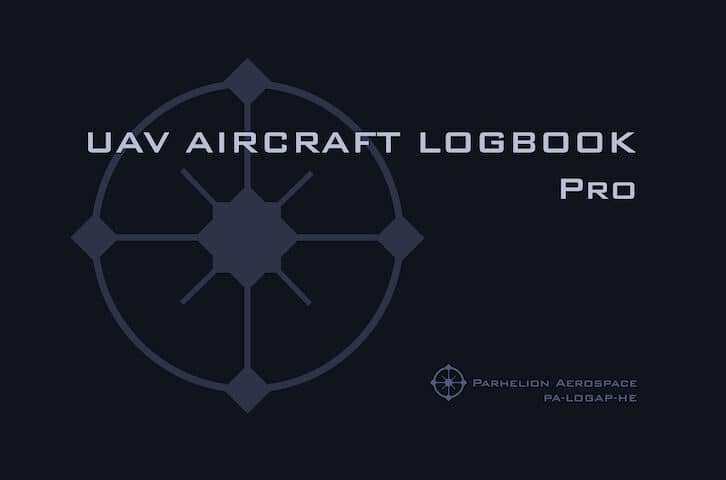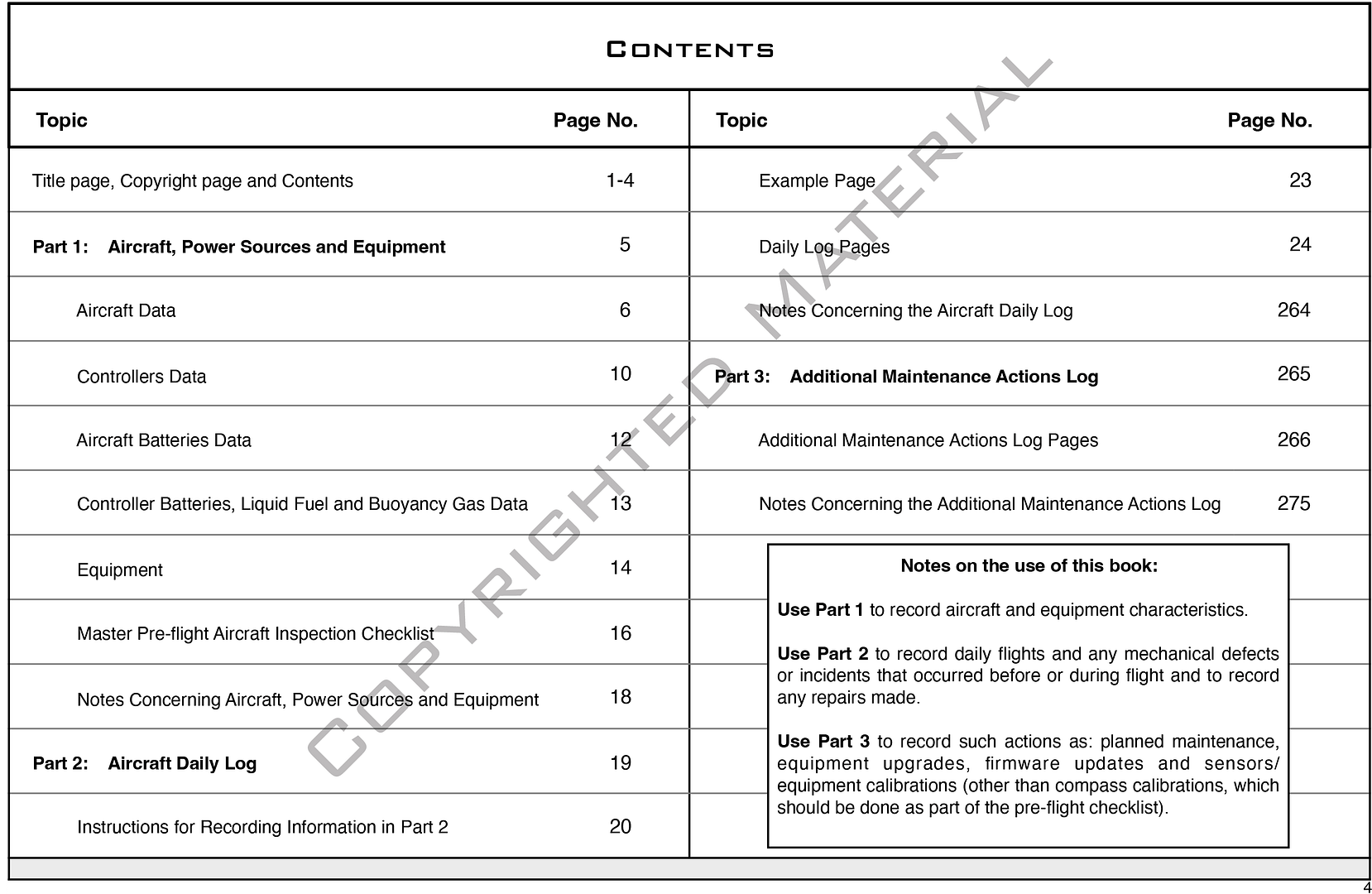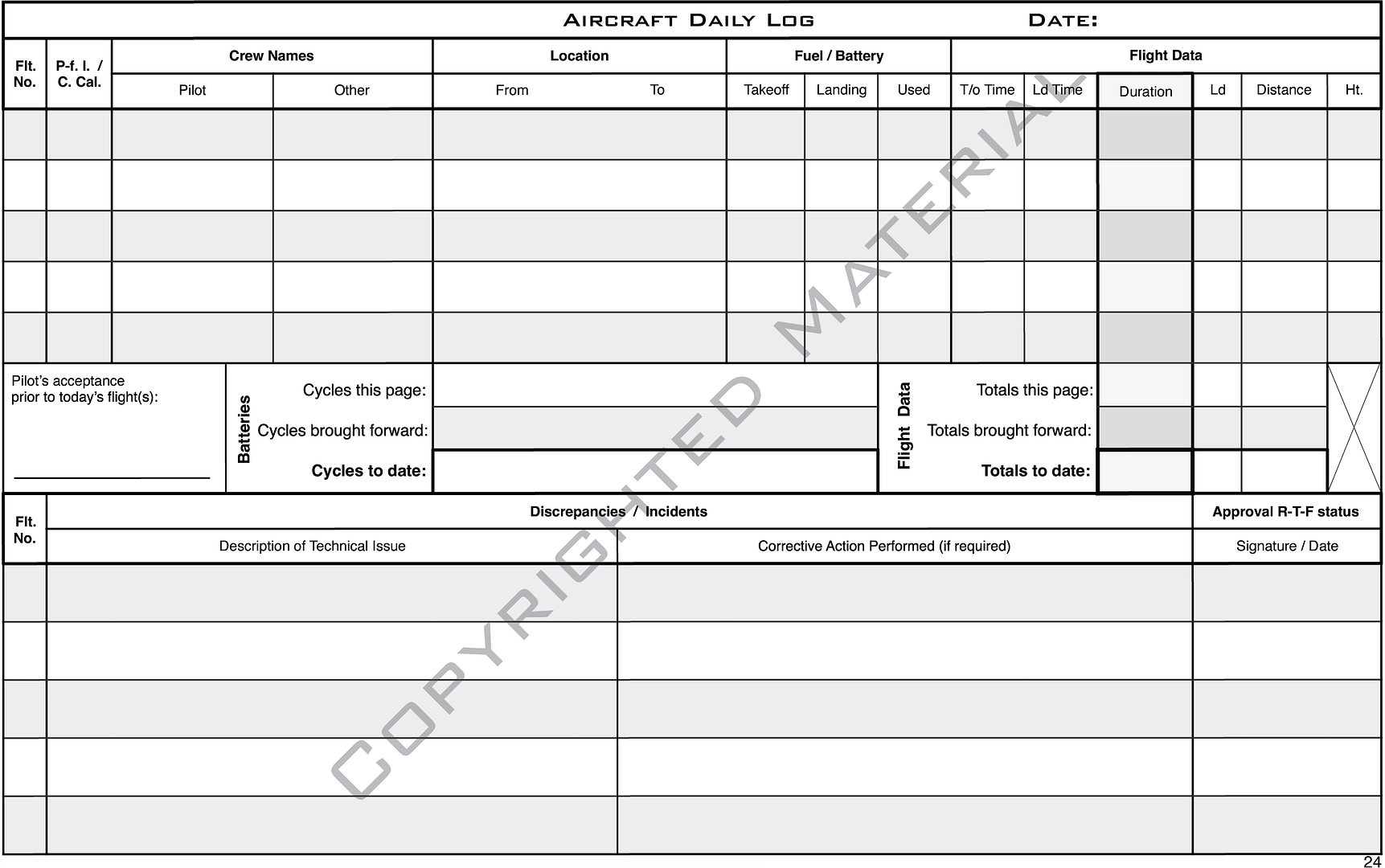Use drone aircraft logbooks to record your UAV’s technical history.
You are a serious, possibly commercial, drone operator and you want to run your drone program professionally. You routinely use all of the tools necessary to achieve that goal – but have you considered using a technical logbook to make proper records of your aircraft’s use and maintenance histories? You ought to, since your drone program will benefit from doing so.
In this Parhelion Article we will refer to such a book as an “aircraft” logbook, and explain what it is and what it is not. We will discuss how using drone aircraft logbooks benefits you, what they should consist of, and how to tell a good one from a bad one.
Let’s take a look!
To begin, what are drone aircraft logbooks?
Ship’s logbooks, recording weather, navigation and operational information, date back to at least the 17th century, and remain in use today. Standard (piloted) aircraft keep a “ship’s log” as well, that records aircraft use and maintenance. These, along with official registrations, ownership papers and insurance certificates, are considered indispensable documents for such craft. It is an obvious inference that such a logbook is dedicated to a single vessel.
In the case of standard aircraft the purpose of such a book is to record the history of the machine, rather than to record pilot experience. In fact, an aircraft’s logbook may reflect usage by several different pilots, depending upon who is permitted to fly it.
Such a book is often set up as a daily log, in which all the pertinent events of a given day are recorded on one or two pages. These data can be divided into flight information and technical, or maintenance, information. The logbook provides separate sections in which to record each kind of data, per day. Additional sections, not located with the daily log pages but perhaps in the front or back of the book, may be provided for recording planned maintenance actions that are not part of a given flight day.
It is appropriate and valuable for drone operators to use such a logbook as well – the benefits of doing so will be explained below. The thing to keep in mind is that, just as ship’s logs and jet aircraft logbooks differ in what they record, so does a drone aircraft logbook differ from the others. Just what ought to be present in a dedicated drone aircraft logbook will be explained in this article.
By the way, they are not “pilot logbooks.”
Aircraft logbooks are not the same as pilot logbooks. Drone pilot logbooks, which we have described in another Parhelion Guide Article, record the flight data of an individual aviator’s flying activities. Unlike the aircraft log described above a pilot logbook is clearly not dedicated to a single machine, but instead may, and over time likely will, record data from the use of several different aircraft, depending upon the pilot’s opportunities.
A pilot logbook is concerned primarily with operational information, such as flight locations and durations, as well as personal factors such as whether the flight was instructional or otherwise. It reflects the totality of the pilot’s flying experience and, even though a minor amount of aircraft technical data may be recorded, its focus is on the pilot, not the machine.
What are the benefits of using a drone aircraft logbook?
The purposes and chief benefits of keeping a detailed drone aircraft logbook are that it provides the operator with a clear understanding of how much a given machine has been flown (daily use data) and what its technical history and present status are (maintenance data), regardless of who has flown it. Using such a logbook allows you to accurately assess your aircraft’s airworthiness on any given day. This obviously bears directly upon safety of flight, and, consequently, your reputation.
By recording daily use data (e.g. flight time, etc) you can keep track of the “aging” of your aircraft, which permits you to assess when it needs to be serviced or even sold. The same consideration applies to your aircraft’s accessories/equipment (e.g. batteries and propellers), which also need to be included in your aircraft logbook. By keeping track of their age and amount of use you can better schedule their replacement before they fail and let you down (literally).
By recording any events that may have occurred during the day’s flights (e.g. malfunctions, crashes, etc), as well as repairs accomplished, you can assess the day-to-day maintenance status of your aircraft. Is your drone really ready to fly after that very hard landing, coming on top of previous, similar events? Vital knowledge of earlier hard landings might not have been passed on, in the case of several pilots using the same machine, had they not been written down. Getting all of your pilots to record their flights in your aircraft logbook, and not just in their personal pilot logs, keeps you and everyone who flies your machine up to date.
Additionally, making a written record of periodic scheduled maintenance helps you to know just how much care is being given to your drone, adding to your confidence in its flying ability, as well as helping you to see if more, and perhaps special, maintenance intervention is needed. Written records are obviously superior to memory here, especially if you have several drones.
If an operator is diligent in reviewing all entries and is required to sign off on the airworthiness of the aircraft (again, in the logbook) before flight, then it follows that the operation is likely to proceed with greater assurance of safety from technical faults than if mere guesswork was used.
Don’t forget the money, either.
Secondary, but by no means unimportant, benefits to using a drone aircraft logbook include being able to determine your drone’s monetary value. Knowing your aircraft’s airworthiness and being able to compare this with new, or other used drones of equivalent age and use, should assist you in determining the value of your machine. This can help you to make decisions regarding the amount of hull insurance you may want to carry, as well as assisting your assessments of depreciation, so important in bookkeeping for small businesses.
Finally, and probably most useful, knowing the value of your machine and being able to produce written records (your aircraft logbook) to back that assessment up, are particularly helpful when trying to get its full price when selling your drone. Buyers are more likely to buy with confidence when they see how carefully you have maintained your machine by the completeness of your record.
What are the drawbacks?
Filling out logbooks takes time and discipline. You have to be careful and diligent. We take this as a sign of an operator’s degree of professionalism, however.
Furthermore, dedicated aircraft logbooks, designed specifically for drones, are uncommon. Parhelion Aerospace is the only company that we are aware of that sells traditional paper (hard- or soft-cover) drone aircraft logbooks. Amazon has a selection of these for sale.
So, what’s inside of a drone aircraft logbook?
To maximize the benefits discussed above, you want to find a logbook that has been designed specifically for drones. Standard aircraft logs are often excellent, however they record things that are of no interest to the drone operator, and leave out things that are important to us. At a minimum it would be best to log the following, per flight:
Daily Use, or Flight Data (which might also be found in a pilot logbook):
– date of flight.
– name(s) of the flight crew (pilot, observer/camera operator).
– whether or not the crew performed a pre-flight inspection and/or compass calibration.
– takeoff and landing location(s).
– takeoff and landing time.
– calculated flight duration.
– number of landings accomplished.
– battery charges at takeoff and after landing (or fuel quantities, for liquid-fueled UAVs).
Some flight data, particularly flight duration and number of landings, need to be totaled each page. A running grand-total needs to be kept throughout the book.
Technical, or Maintenance Data (which would most likely not be recorded in the pilots’ logbooks – these items need plenty of space in which to write detailed notes):
– calculated battery cycles, or fuel burn.
– equipment used for the flight (e.g. sensors, etc).
– a description of technical defects found or incidents that occurred.
– a description of the actions taken (e.g. repairs) to resolve the recorded defects or incidents (these will be added after the fact, of course), and whether or not a test flight was performed prior to release for regular use.
– the signature of the person empowered to authorise return-to-flight status after repairs/tests.
Additionally, you may find it helpful to record notes about the purpose of the flight, in order to remain informed about the usefulness of a given drone. You may also find it helpful to record the use of sensors, their settings and the results gained, in order to plan future missions with the authority and efficiency derived from experience.
Finally, as mentioned above, you will need sections in which you can record scheduled inspections and maintenance (e.g. your aircraft’s annual technical review, etc) and their results, as well as equipment bought and aircraft and equipment upgrades of various types, firmware updates and calibrations that you don’t necessarily do on a daily basis but that are definitely part of your aircraft care scheme.
An even better logbook:
If you want something more than the minimum, however, you should look for a book that, in addition to the items listed above, allows you to record in detail the identification data of the drone for which the log is being kept, as well as for the power source (e.g. batteries or fuel appropriate to your aircraft) and the equipment (e.g. controller(s), sensors, etc) that you have assigned to this aircraft. Identification data include such things as present owner name, address at which the aircraft is stored, insurance policy information, manufacturer and model names, serial numbers, dates of manufacture, battery capacities, whether the items were bought new or used, etc.
Additionally, a superior drone aircraft logbook will have instructions and example pages in the front, explaining how the book is to be filled out. It may also have a page or two in the back for general notes of your own choosing.
Finally, if you are considering a paper, traditional logbook then the best choice is a hard-cover version. Soft-cover logbooks are tempting, because they seem inexpensive, but the durability of hard-cover books make your records more permanent, which is an advantage that a serious drone operator does not want to overlook.
An even worse logbook:
Obviously, if any of the items mentioned above is not present in a given logbook then it may be classed as inferior. The only things in particular we would like to mention in this category is that you should be careful of logs that suggest that they are both pilot and technical logbooks, for the reasons stated below (some are better than others), and avoid those that waste space (and your time!) with areas dedicated to drawing flight routes. This sort of thing is not ever recorded in standard aircraft logbooks and has no place in a professional drone aircraft logbook, either (or professional drone pilot logbooks, for that matter).
So, what do you need, then?
Every drone pilot needs a pilot logbook to record his/her own flying, no matter how many different drones they fly. Every drone operator/owner needs an aircraft logbook for each of the machines they have. If you are a pilot and the owner/operator of your drone(s) then of course you will need both: a single pilot logbook for yourself and a drone aircraft logbook for each of your machines. If you are an operator that has one or more drones that may be flown by several pilots then you will use a separate aircraft logbook for each of your machines, and the pilots will record their own flight data in their personal drone pilot logbooks. Again, this is the way it’s done in standard aviation and it seems to us that it’s an equally valuable practice in the UAV world.
For those who don’t want to do that much post-flight writing, however, a decently comprehensive drone pilot logbook might do the trick, assuming that it permits you to record at least rudimentary maintenance data. The problem with using a pilot log alone, however, is that it becomes a confused mess the moment that you fly a second aircraft and want to record those flights in the same logbook. How do you keep the maintenance histories of the two aircraft separate in your pilot log? A lot of notes in the margins and confusing labels and arrows here and there result. We feel that it’s better to have a pilot logbook for all of our flying and a separate aircraft log for each of our drones.
This situation might be easier if you are using a digital logbook. Some digital logbook services can sort the data you put in and produce collated outputs for you. There are, however, disadvantages to using electronic logbooks that you should be aware of before you buy. To compare the pros and cons of digital and paper logbooks, read our Parhelion Guide article: Digital or Traditional Logbook.
Bottom Line:
Drone operators can benefit from the use of aircraft logbooks as well as standard aircraft operators can, and we believe that it is an essential best practice for commercial drone operators or for anyone who is truly serious about flying safely and economically. Using guesswork regarding the airworthiness of your machine can be misleading, and can result in property damage or even injuries if the guessing proves to be inaccurate. Careful use of a dedicated logbook, however, can help you to avoid such situations by helping you to accurately assess your drone’s airworthiness on any given day.
So we say: log your data! Be smart about the differences between personal flight data and information about aircraft use and condition. While there are many views on the subject, ours are derived from over 35 years of professional flying. To review or buy logbooks that fulfill the criteria stated in this article, click on UAV Logbooks. Published by Parhelion Aerospace.



